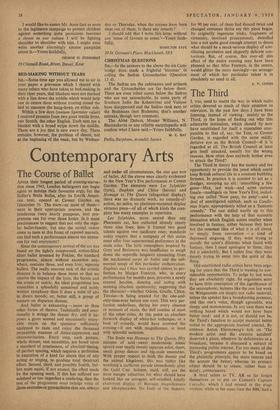Contemporary Arts
The Course of Ballet
AFTER their longest period of evening-starva- tion since 1945, London balletgoers can begin again to indulge their favourite orgy, for the Sadler's Wells Ballet, after its fourth Ameri- can tour, opened at Covent Garden on December 31. The stars—or most of them— were in their appropriate courses, and the ponderous (very nearly pompous, too) pro- gramme ran for over three hours. Is it mere preciousness to suggest that not only the regu- lar ballet-fancier, but also the casual visitor come to taste at this fount of reputed marvels, can find such a performance almost too strenu- ous for real enjoyment?
Since the contemporary revival of the art was based on the tightly compressed, action-filled short ballet invented by Fokine, the standard programme, almost without exception any- where, contains three, and even four, separate ballets. The really onerous task of the artistic director is to balance these items so that we receive the impact of the lyric, the heroic and the comic or satiric. An ideal programme less resembles a splendidly conceived and nobly written symphony than it does a suite of airs in divers moods; or, better still, a group of sonnets on disparate themes.
And ballet is exhausting — more so than other forms of theatre. Technically and emo- tionally it wrings the dancer• dry, and it im- poses a great sensual and emotionally enjoy- able strain on the spectator sufficiently equipped to taste and enjoy the thousand perceptible nuances of dance-expression and characterisation. Every step, each gesture, whole dances, vast ensembles, are based upon a standard of conciseness, of absolute timing, of perfect spacing, which requires a perfection in execution of a kind far above that of any acting or singing, to produce total theatrical effect. Second, third, and possibly fourth, bal- lets must equal, if not exceed, the effect made by the opening work. If this has suffered too subdued or too imperfect a rendering, then the rest of the programme .must indulge sonic of 4hose ecstasies,or pyrotechnics that are, always and under all circumstances, the sine qua non of ballet. All the above were clearly evidenced in the New Year's Eve performance at Covent Garden. The elements were Les Sylphides (lyric), Daphnis and Chloe (heroic) and Homage to The Queen (allegorical display); there was no dramatic work, no comedy-of- action, no satire, no platinum-mounted display virtuoso piece—of all of which kinds the com- pany has many examples in repertoire.
Les Sylphides, more sacred than any Pharaonic cat, has outlasted already ninety times nine flues; here it framed two good talents against two mediocre ones; standards today require that a company of this status must offer four supernormal performers in the main roles. The lyric atmosphere inspired by Grey and Beriosova was insufficient to weigh down the soporific languors emanating from the mechanical corps de ballet and the sub- normal tempi of this particular orchestration. Daphnis and Chloe was carried almost to per- fection by Margot Fonteyn, who, in every performance for months past, presents a newly created heroine, dancing and acting with seeming absolute spontaneity, suggesting that the character—whether Odette, Giselle, Chloe, Tiresias—is being created for the one-and- only-time-ever before our eyes. This very per- fection • underlines, during her every absence or moment of stasis, the dull routine of most of the other roles. At this point an absolute firework display of white-hot technique, or a bout of comedy, would have crowned the evening—if not with magnificence, at least with splendid satiation.
The finale was Homage to The Queen, fifty minutes of acid - sweet modernistic music spread over nearly twenty separate solos, duets, small group dances and big-scale ensembles. With proper respect to both the dancer and the animal kingdoms, this was rather like watching a carthorse parade immediately after the Gold Cup. Solemn, staid, stiff, are the most meagre adjectives for what should have looked like an arrogant, self-satisfied, totally exuberant display of Baroque magnilicences and idiosyncrasies. No fault of the dancers.
for 90 per cent. of them had danced twice and changed ostumes thrice ere this piece began. Its originally ingenious tricks, fragments of virtuosity, involved processionals, dwindled into a not quite good enough attempt to dance what should be a mock-serious display of scin- tillating acrobatics and elegantly delicate con- tortions. But, of course, this over-all dim effect of the entire evening may have been planned so that Miss Fonteyn, in the centre, would glitter the more movingly—an arrange- ment of which her particular talent is in absolutely no need at all.
A. V. COTON


































 Previous page
Previous page